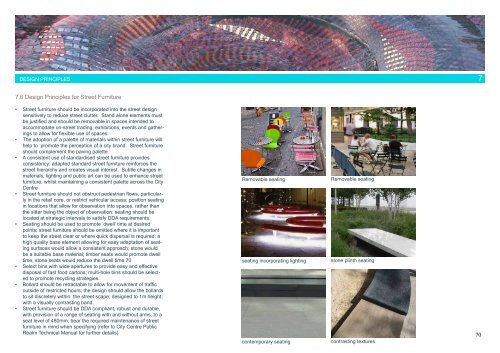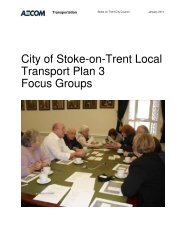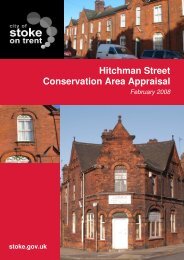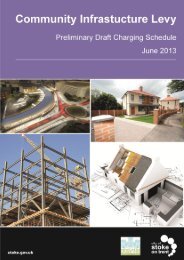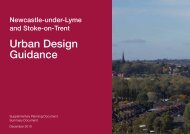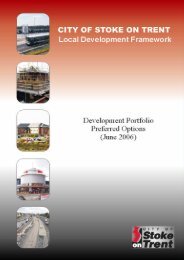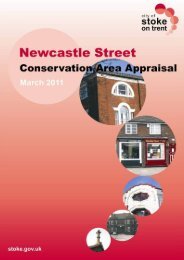Consultation Draft 1 - Stoke-on-Trent City Council
Consultation Draft 1 - Stoke-on-Trent City Council
Consultation Draft 1 - Stoke-on-Trent City Council
You also want an ePaper? Increase the reach of your titles
YUMPU automatically turns print PDFs into web optimized ePapers that Google loves.
DESIGN PRINCIPLES 7<br />
7.6 Design Principles for Street Furniture<br />
• Street furniture should be incorporated into the street design<br />
sensitively to reduce street clutter. Stand al<strong>on</strong>e elements must<br />
be justified and should be removable in spaces intended to<br />
accommodate <strong>on</strong>-street trading, exhibiti<strong>on</strong>s, events and gatherings<br />
to allow for flexible use of spaces.<br />
• The adopti<strong>on</strong> of a palette of materials within street furniture will<br />
help to promote the percepti<strong>on</strong> of a city brand. Street furniture<br />
should complement the paving palette.<br />
• A c<strong>on</strong>sistent use of standardised street furniture provides<br />
c<strong>on</strong>sistency: adapted standard street furniture reinforces the<br />
street hierarchy and creates visual interest. Subtle changes in<br />
materials, lighting and public art can be used to enhance street<br />
furniture, whilst maintaining a c<strong>on</strong>sistent palette across the <strong>City</strong><br />
Centre<br />
• Street furniture should not obstruct pedestrian flows, particularly<br />
in the retail core, or restrict vehicular access: positi<strong>on</strong> seating<br />
in locati<strong>on</strong>s that allow for observati<strong>on</strong> into spaces, rather than<br />
the sitter being the object of observati<strong>on</strong>: seating should be<br />
located at strategic intervals to satisfy DDA requirements.<br />
• Seating should be used to promote ‘dwell’ time at desired<br />
points; street furniture should be omitted where it is important<br />
to keep the street clear or where quick dispersal is required: a<br />
high quality base element allowing for easy adaptati<strong>on</strong> of seating<br />
surfaces would allow a c<strong>on</strong>sistent approach; st<strong>on</strong>e would<br />
be a suitable base material; timber seats would promote dwell<br />
time, st<strong>on</strong>e seats would reduce the dwell time.70<br />
• Select bins with wide apertures to provide easy and effective<br />
disposal of fast food cart<strong>on</strong>s; multi-hole bins should be selected<br />
to promote recycling strategies.<br />
• Bollard should be retractable to allow for movement of traffic<br />
outside of restricted hours; the design should allow the bollards<br />
to sit discretely within the street scape; designed to 1m height,<br />
with a visually c<strong>on</strong>trasting band.<br />
• Street furniture should be DDA compliant, robust and durable,<br />
with provisi<strong>on</strong> of a range of seating with and without arms, to a<br />
seat level of 480mm; bear the required maintenance of street<br />
furniture in mind when specifying (refer to <strong>City</strong> Centre Public<br />
Realm Technical Manual for further details)<br />
Removable seating<br />
seating incorporating lighting<br />
c<strong>on</strong>temporary seating<br />
Removable seating<br />
st<strong>on</strong>e plinth seating<br />
c<strong>on</strong>trasting textures<br />
70 71


